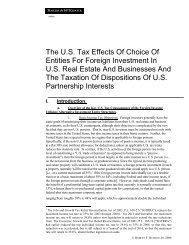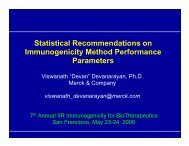Managing Compliance With Your Customer Identification ... - IIR
Managing Compliance With Your Customer Identification ... - IIR
Managing Compliance With Your Customer Identification ... - IIR
You also want an ePaper? Increase the reach of your titles
YUMPU automatically turns print PDFs into web optimized ePapers that Google loves.
<strong>Managing</strong> <strong>Compliance</strong> <strong>With</strong> <strong>Your</strong> <strong>Customer</strong> <strong>Identification</strong> Programs<br />
By Applying the Latest Know <strong>Your</strong> <strong>Customer</strong> Techniques<br />
Moderator:<br />
Alan Sorcher<br />
Vice President and<br />
Associate General Counsel<br />
Securities Industry Association<br />
Panelists:<br />
Tara Loftus<br />
Executive Director and<br />
Head of Money Laundering<br />
Prevention<br />
UBS Financial Services<br />
Michelle Neufeld<br />
<strong>Compliance</strong> Director,<br />
Assistant General Counsel<br />
JPMorgan Chase<br />
Jack Sonnenschein<br />
Senior Advisor,<br />
Global Anti-Money Laundering<br />
Citigroup<br />
Don Carlson<br />
<strong>Compliance</strong> Program Manager<br />
Bank of America
CIP and KYC:<br />
When is Enough Enough?<br />
Jack Sonnenschein
<strong>Customer</strong> <strong>Identification</strong> Program is Risk<br />
Based<br />
Risk assessment of customer base and product<br />
offerings<br />
•The types of accounts offered by the bank.<br />
•The bank’s methods of opening accounts.<br />
•The types of identifying information available.<br />
•The bank’s<br />
» size,<br />
» location<br />
» customer base,<br />
» geographic locations
When are CIP and KYC complete?<br />
a) Obtain Name, Date of birth, Address and<br />
<strong>Identification</strong> number
When are CIP and KYC complete?<br />
a) Obtain Name, Date of birth, Address and<br />
<strong>Identification</strong> number<br />
b) Verify by review of an unexpired governmentissued<br />
form of identification evidencing:<br />
customer’s nationality or residence and<br />
bear a photograph (driver’s license or<br />
passport).
When are CIP and KYC complete?<br />
a) Obtain Name, Date of birth, Address and<br />
<strong>Identification</strong> number<br />
b) Verify by review of an unexpired governmentissued<br />
form of identification evidencing:<br />
customer’s nationality or residence and<br />
bear a photograph (driver’s license or<br />
passport).<br />
c) Compare with Government Lists
When are CIP and KYC complete?<br />
a) Obtain Name, Date of birth, Address and<br />
<strong>Identification</strong> number<br />
b) Verify by review of an unexpired governmentissued<br />
form of identification evidencing:<br />
customer’s nationality or residence and<br />
bear a photograph (driver’s license or<br />
passport).<br />
c) Compare with Government Lists<br />
d) All of the above
When are CIP and KYC complete?<br />
a) Obtain Name, Date of birth, Address and<br />
<strong>Identification</strong> number<br />
b) Verify by review of an unexpired governmentissued<br />
form of identification evidencing:<br />
customer’s nationality or residence and<br />
bear a photograph (driver’s license or<br />
passport).<br />
c) Compare with Government Lists<br />
d) All of the above
At Account Opening:<br />
‣Determine appropriate level of due diligence required to<br />
evaluate various potential risks that may be posed by new<br />
customer<br />
Ongoing Relationship:<br />
‣Identify as early as possible suspicious activity and/or<br />
customers that may represent money laundering or terror<br />
financing risks
Meeting the ongoing challenge of CIP and<br />
KYC<br />
Screening Capabilities<br />
‣Portfolio reviews<br />
‣Searching and Matching<br />
‣Workflow and documentation<br />
Information<br />
‣Risk based<br />
‣Up-to-date Information Sources<br />
‣Relationships
Screening Capabilities:<br />
Enable efficient and cost effective checking of<br />
high risk entity information from internal and<br />
external databases<br />
Advanced entity resolution and disambiguation<br />
Allow for periodic reviews of entire customer<br />
portfolios<br />
Allow for management of false positives<br />
Serve as a tool in documenting name searches<br />
against databases in order to support due<br />
diligence and investigations.
External Information Sources<br />
•Government lists<br />
•International organization lists<br />
•Commercially available databases<br />
» Terrorists<br />
» Financial crimes<br />
» Narcotics<br />
» Senior public officials<br />
» Military figures<br />
» Religious leaders<br />
» Charities
External Information Sources<br />
•Commercially available databases<br />
(continued)<br />
» Close associates<br />
» Relatives<br />
» Aliases<br />
» Affiliations with profit or non-profit<br />
entities
Internal Information Sources<br />
•Suspicious Activity Reports<br />
•Internal Investigations<br />
•Closed Accounts or Terminated<br />
Relationships<br />
•Criminal Subpoenas<br />
•Negative Lists
Internal Information Sources – The Details:<br />
Identify and inventory the types of lists and how<br />
used<br />
Determine practice standards for lists and key<br />
events :<br />
•Appearance on government list,<br />
•Filing of suspicious activity report,<br />
•Account closure or termination of relationship<br />
•Receipt of criminal subpoena<br />
•Involvement in loss or fraudulent transaction<br />
•Subject of internal investigation<br />
•Negative press (financial or otherwise)
Internal Information Sources – The Details:(continued):<br />
Practices around keeping lists current<br />
Extent of detailed information added to lists<br />
Review and approval for changes to lists<br />
Balance internal sharing and “tipping-off” risk<br />
Information security, privacy and data sharing<br />
Technology and workflow
Summary<br />
CIP and KYC is an ongoing effort<br />
‣Risk Based<br />
‣Integrate multiple information sources<br />
‣Technology and workflow<br />
‣Search and match<br />
‣False positive management<br />
‣Document work done
Michelle Neufeld – JP Morgan Chase<br />
Tara Loftus – UBS Financial Services<br />
Section 326 – <strong>Customer</strong> <strong>Identification</strong> Program Basic Requirements<br />
1. Verify the identity of each customer to the extent reasonable and<br />
practicable<br />
2. Maintain records<br />
3. Determine whether the person appears on a list designated for purposes of<br />
this rule.
Definition of <strong>Customer</strong><br />
includes:<br />
Definitions<br />
- A Person (Individual, corporation, partnership, trust, estate, etc.) that opens<br />
a new account<br />
- An individual who opens a new account for:<br />
1) an individual who lacks legal capacity<br />
2) an entity that is not a legal person<br />
does not include:<br />
- A person who has an existing account (if firm reasonably believes knows<br />
person’s true identity)<br />
- Publicly-listed companies on certain U.S. Exchanges<br />
- Financial institutions regulated by a Federal functional regulator<br />
- State-regulated banks<br />
- Federal, state and local government entities
Omnibus - October 1, 2003<br />
Recent Guidance<br />
(1) The omnibus account or relationship is established by or on behalf of a<br />
financial intermediary for the purpose of executing transactions that will<br />
clear or settle at another financial institution, or the omnibus accountholder<br />
provides limited information to the broker-dealer solely for the purpose of<br />
delivering assets to the custody account of the beneficial owner at another<br />
financial institution;<br />
(2) the limited information given to the broker-dealer about the beneficial<br />
owner is used primarily to assist the financial intermediary with<br />
recordkeeping or to establish sub-accounts that hold positions for a limited<br />
duration to facilitate the transfer of assets to another financial institution;<br />
(3) all transactions in the omnibus account or sub-accounts at the brokerdealer<br />
are initiated by the financial intermediary; and<br />
(4) the beneficial owner has no direct control over the omnibus account or<br />
sub-accounts at the broker-dealer.
Recent Guidance<br />
Agent Lending – April 26, 2006<br />
(1) the agent lender’s customer does not initiate the transaction,<br />
(2) the agent lender determines the securities that will be used to fulfill<br />
the broker-dealer borrower’s request,<br />
(3) the broker-dealer borrower records the loan transaction into an<br />
account in the name of the agent lender, and<br />
(4) the information about the agent lender’s customer is generally<br />
provided to the broker-dealer borrower after the fact and principally<br />
for the purposes of determining credit risk and reporting regulatory<br />
capital.
Section 326 – <strong>Customer</strong> <strong>Identification</strong> Program Basic Requirements<br />
Definition of Account<br />
- A formal or contractual relationship with a financial institution to provide<br />
financial products and services<br />
*Exceptions include:<br />
ERISA Accounts<br />
Transfer exception - Accounts acquired through acquisition, merger, etc.
Core Four<br />
<strong>Identification</strong> Information – Core Four<br />
1. Name<br />
Must be full legal name<br />
2. Date of Birth, for an individual<br />
3. Physical Address<br />
Purpose – law enforcement<br />
drop boxes<br />
4. <strong>Identification</strong> number<br />
Must be US taxpayer id (SSN) for US Persons<br />
Application for taxpayer id
Section 326 – <strong>Customer</strong> <strong>Identification</strong> Program Basic Requirements<br />
‣ Verify client’s identity by<br />
documentary or nondocumentary<br />
means<br />
‣ Practical Implications<br />
‣ Students<br />
‣ Elderly<br />
‣ Foreign Language<br />
‣ Notice of verification<br />
provided to clients<br />
‣ Maintain records of the<br />
information used to verify<br />
‣ Core 4 - 5 years after account is<br />
closed<br />
‣ Description of documents, verification<br />
method and resolution of issues – 5<br />
years after the record is made<br />
‣ Close accounts if unable to<br />
verify identity<br />
‣ Additional Review for<br />
Certain <strong>Customer</strong>s<br />
‣ SAR filing required?<br />
‣ Cross reference clients<br />
against lists of suspected<br />
terrorists or terrorist<br />
organizations<br />
‣ No List so designated<br />
‣ OFAC/SDN is a separate<br />
requirement<br />
‣ CIP must be Risk-based
CIP vs. KYC/Due Diligence<br />
• CIP is only the first step<br />
• Risk Assess Accounts to determine level of KYC/Due Diligence<br />
• Client Risk<br />
• Jurisdiction Risk<br />
• Business/Transaction Risk<br />
• Risk Category should establish:<br />
• Additional Information/Documents & Vetting methods required<br />
• Level of Approvals Needed<br />
• Timing of Account Approvals<br />
• Frequency of KYC reviews<br />
• Type of Ongoing Monitoring required
CIP “In Control”: A Process Engineering Perspective<br />
Complete Set of AML CIP/KYC Process Are:<br />
Defined (Policy and Procedures)<br />
Measured (via Critical To Quality attributes (CTQ’s))<br />
In Control (Statistical Process Controls, Change Controls, with<br />
Formal Control Plan)<br />
Active Process Owners (Effective Execution, Training and Tools)<br />
Meeting CTQ’s (Capable Processes)<br />
Continuous Improvements (Where Needed)<br />
Meets The Business Need(s)<br />
Passes Internal Audits<br />
Certified Through Process Excellence!<br />
Passes Regulatory Exams
















